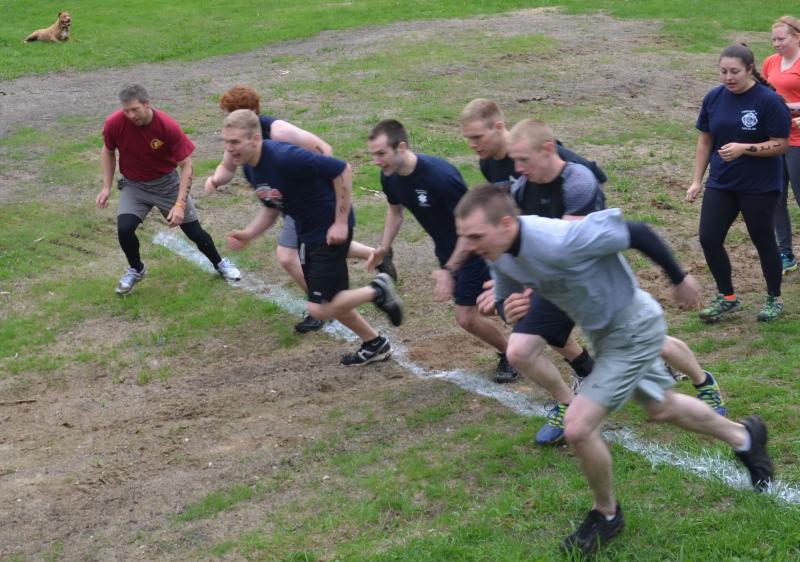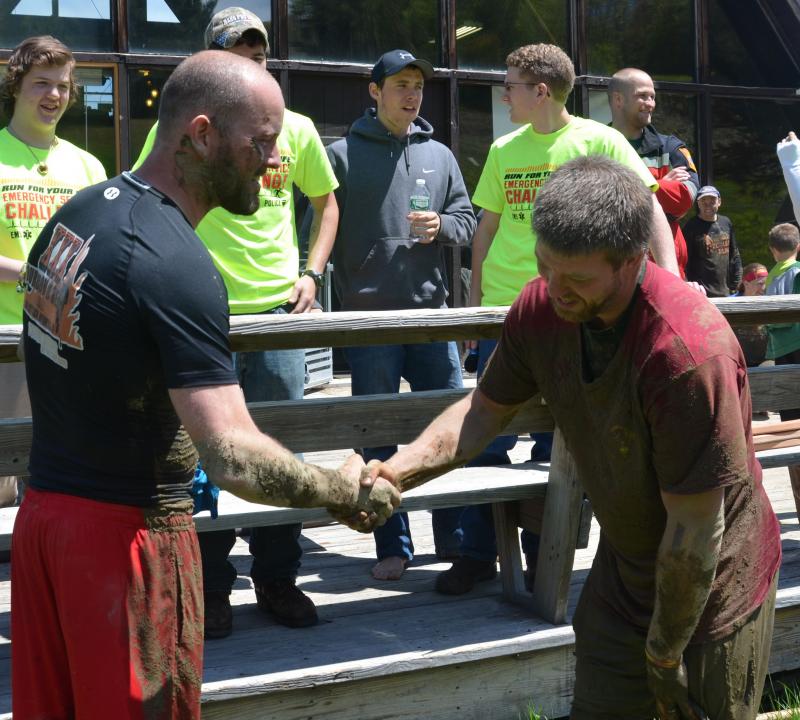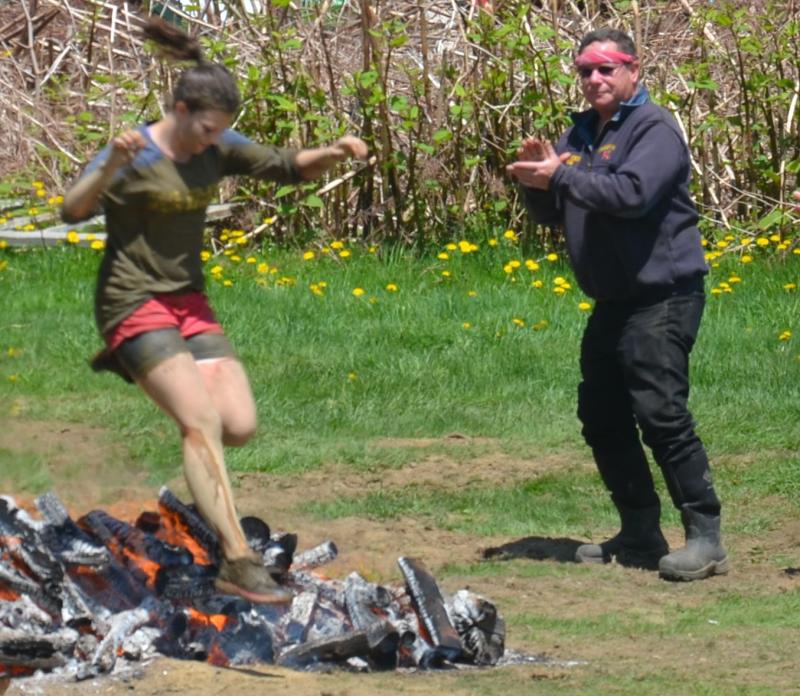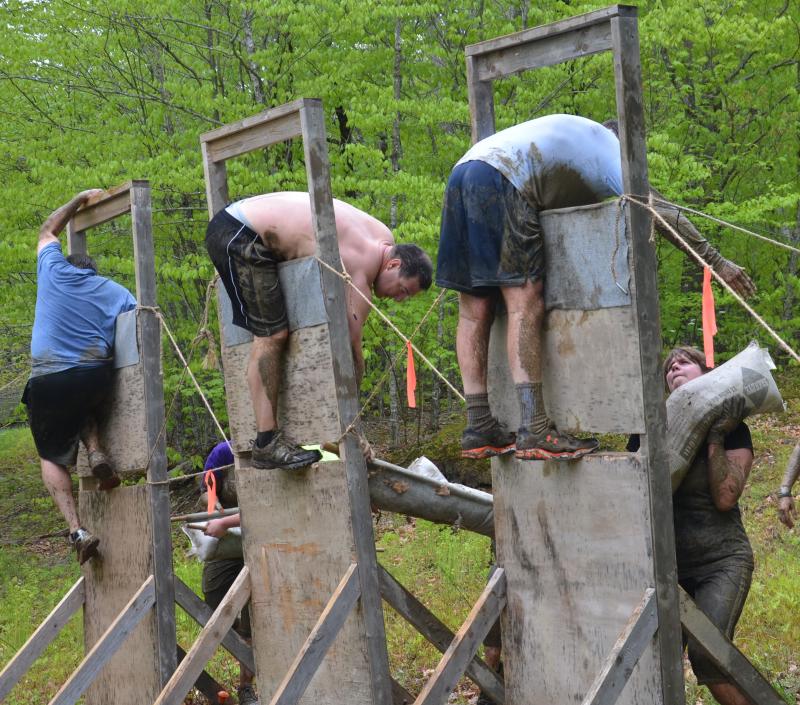Training to Run For Your Life: Push-ups, burpees, road work, protein and carbs
 In 2014, the first heat of runners cross the starting line. Shawn St. Cyr, of Jefferson, is at the far left in a red shirt. He ran three laps, up and down Ragged Mountain, in total, 15K, including all of the obstacles of the annual Run For Your Life Emergency Service Challenge. (Photo by Lynda Clancy)
In 2014, the first heat of runners cross the starting line. Shawn St. Cyr, of Jefferson, is at the far left in a red shirt. He ran three laps, up and down Ragged Mountain, in total, 15K, including all of the obstacles of the annual Run For Your Life Emergency Service Challenge. (Photo by Lynda Clancy)
 Three laps, and the end of the Emergency Service Challenge obstacle course 5K, for Shawn St. Cyr, 2014. (Photo by Lynda Clancy)
Three laps, and the end of the Emergency Service Challenge obstacle course 5K, for Shawn St. Cyr, 2014. (Photo by Lynda Clancy)
 (Photo by Lynda Clancy)
(Photo by Lynda Clancy)

 (Photo by Lynda Clancy)
(Photo by Lynda Clancy)
 (Photo by Lynda Clancy)
(Photo by Lynda Clancy)

 In 2014, the first heat of runners cross the starting line. Shawn St. Cyr, of Jefferson, is at the far left in a red shirt. He ran three laps, up and down Ragged Mountain, in total, 15K, including all of the obstacles of the annual Run For Your Life Emergency Service Challenge. (Photo by Lynda Clancy)
In 2014, the first heat of runners cross the starting line. Shawn St. Cyr, of Jefferson, is at the far left in a red shirt. He ran three laps, up and down Ragged Mountain, in total, 15K, including all of the obstacles of the annual Run For Your Life Emergency Service Challenge. (Photo by Lynda Clancy)
 Three laps, and the end of the Emergency Service Challenge obstacle course 5K, for Shawn St. Cyr, 2014. (Photo by Lynda Clancy)
Three laps, and the end of the Emergency Service Challenge obstacle course 5K, for Shawn St. Cyr, 2014. (Photo by Lynda Clancy)
 (Photo by Lynda Clancy)
(Photo by Lynda Clancy)

 (Photo by Lynda Clancy)
(Photo by Lynda Clancy)
 (Photo by Lynda Clancy)
(Photo by Lynda Clancy)

Last May, Shawn St. Cyr, a father of three and industrial arts teacher at Lincoln Academy in Newcastle, ran the 5K Run For Your Life Emergency Service Challenge course at the Camden Snow Bowl in 2014 not just once, but three times. That’s three times up and down the 1,200 Ragged Mountain, with stops to climb ropes, crawl through the mud under barbed wire, and haul bags of sand over fences. He amazed everyone with his drive, and on the last lap in (that makes it a 15K) — caked with mud and panting hard — he was grinning ear to ear.
The best part? A challenge to test one’s personal mettle.
The worst part? He forgot his bananas at home, and just about blacked out on the final leg for lack of glucose.
But he is doing it again this year, and might even take a fourth lap through the course. This, from a man who just started competing in obstacle course races two years ago. Now, he takes on Tough Mudders and other similar races through the summer and well into the fall with zeal, and a solid sense of humor. He doesn’t take himself too seriously, but he loves to train and excel.
He is even anticipating doing the World’s Toughest Mudder, a November race in the desert around Las Vegas. A 24-hour race.
St. Cyr’s first race of the season, however, is always the annual Run For Your Life Challenge at the Snow Bowl, a May 23 5K whose purpose is to raise awareness of the need for more involvement in local fire departments and emergency response, either volunteer or career. It is not a race just for firefighters and EMTs, although they host it. It is a race to heighten visibility of a community need for more public participation on their local emergency response team.
It is also a race that appeals to runners of varying abilities and backgrounds — teachers, cops, doctors, business owners — who like to tackle a rugged competition with a little more dimension than a road race.
“I really like Camden for my opening race,” said St. Cyr. “The hills are what really challenge me.”
“The plan this year is at least three laps,” he said in late April, after returning from a Habitat for Humanity service trip to Guatemala with 12 Lincoln Academy sophomores, juniors and seniors. “As long as the race runners don't mind me running another wave, I’m considering doing four.”
St. Cyr started training in March for the third annual Run For Your Life Emergency Service Challenge. He coaches wrestling at Lincoln Academy through the winter, and said that keeps him in shape until the end of February. Then, he turns his attention to training for obstacle courses.
“Two months before the first race, I try to run every other day,” he said. “On off days, I do circuit training and cardio. That involves two minutes with cardio, followed by one minute of push-ups, and two minutes cardio. The cardio can be running circles in the weight room to jumping jacks, jump roping and box jumps.”
He also incorporates power training moves — push ups, burpees, leap frogs — all for at least an hour.
St. Cyr maintains a weekly running average of 35 to 40 miles, divided by three short runs and a long run. His long run is 24-plus miles, often times “a lot of loops in Jefferson,” he said.
He starts in Jefferson Village, where he lives, and runs different roads from there, including the North Mountain Road.
“Two years ago, Camden was the first obstacle race I had ever done,” said St. Cyr. “The next weekend after that, I did a Tough Mudder. Last year, I had the bug.”
That bug sends him all over New England (the Tough Mountain Challenge at Sunday River), Vermont for Tough Mudders, and down to New Jersey, for more Tough Mudders.
The Run For Your Life Emergency Service Challenge is a popular 5K organized by Midcoast first responders, and sends runners of all ages — from teenagers to those in their mid-60s — and abilities over a rugged course.
The Challenge appeals to the seasoned triathlete, as well as the novice runner, and presents challenges such as “Blazing Forearms,” “Bucket Brigade,” “Rescue Sandy” and other obstacles that are inspired by situations that firefighters, EMTs and rescue personnel encounter in their work.
The goal of the race is the heighten awareness of the need for more community involvement in local emergency services, whether volunteer or career. The Run For Your Life is also held to encourage all runners, from all walks of life, to challenge their personal best.
See photos from 2014 and 2013 annual Run For Your Life Emergency Service Challenge here.
To learn more about the 2015 RFYL and to register, click here.
“It's the challenge I like,” he said.
He is not necessarily looking to be top dog, with the best time. For St. Cyr, it is the exhileration of finding his personal best.
“That's why I do multiple laps,” he said. “The first year, I did just one lap at each race. Once you're trained up, one lap can get easy. Generally going in, I pick the number of laps I think possible.”
Of all the obstacle course races he has done, however, the geography of Camden Snow Bowl remains his favorite.
“With the terrain Camden offers, it is definitely a challenging race,” he said. “The straight-up rates right up there with me. You run up a little bit, and sideways.”
But he is tuned in now, more than ever, to what his body requires to take on such a rigorous challenge. Last year, it hit home hard.
“I just made it through,” he said. “I had forgotten my fuel. I was planning on eating, getting some glucose at the bottom of the mountain. I struggled in the first half of last lap.”
That fuel was the bananas and bars he had left in the car.
“I just completely forgot,” he said. “It hit me a half-mile in. I was really weak. I thought I might have had to bale the last lap.”
It was the same with water, although, “I did remember to grab a quick drink at the bottom.”
He recommends carrying glucose, in paste form or gummies, on the trail.
“Usually I carry some with me,” he said. “And bananas give you a boost.”
His diet through his training months gets more involved as he nears the events. St. Cyr eats a regular diet — chicken, fish, and some red meat — but he ups the frequency: three meals, plus three snacks, a day.
Before a race, he will begin to load on carbohydrates, without consuming a lot of protein: “Tons of carbs, rice and potatoes and bread.”
“I don't watch what's on it,” he said.
For longer runs, he will make a pre-race drink and infuse it with supplements.
As his training ramps up (last summer he was running 350 miles a month, not including races), he will pay even more attention to what he is consuming, and when.
His gear, on the other hand, is much more simple.
“I run in pretty cheap shoes, $50 Asics,” he said. “I run in those because I put a ton of miles on them in races, running through mud and uphill.”
By the end, they are literally run into the ground.
Prior to each race, he shops for another pair, a lot of the time at Famous Footwear.
“I usually stop on the way to my race and buy a pair to wear after the race,” he said.
Those are his shoe goals. His personal goals are about pushing mind and body beyond perceived limits.
“It's all about finishing it,” he said. “When there is a clock, I get torn a little bit whether I want to pace myself to get in as many laps as I can, or go really fast and sacrifice a lap at the end.”
At the Camden Run For Your Life, he appreciates the ambience on the hill. He is hoping his wife will run a lap this year at Run For Your Life, and his children will be running the children’s course, which is new to the event this year for ages 4 to 12, and complete with tunnels, ladders and balance beams.”
He has some straightforward advice for other runners.
“Believe you can do it,” he said. “I have been amazed at some of the races where I have seen people finish I believe wouldn't have walked across the parking lot. It takes them a lot of time, but they have that want to finish.”
The comraderie on the course is paramount.
“ Everyone is there to help,” he said. “I'll stop at a station and help out people. Everyone is having fun, whether they are working or running.”
And once you get to the top, it’s all downhill... except for a few more worthy obstacles.
Reach Editorial Director Lynda Clancy at lyndaclancy@penbaypilot.com; 207-706-6657
Event Date
Address
United States


































